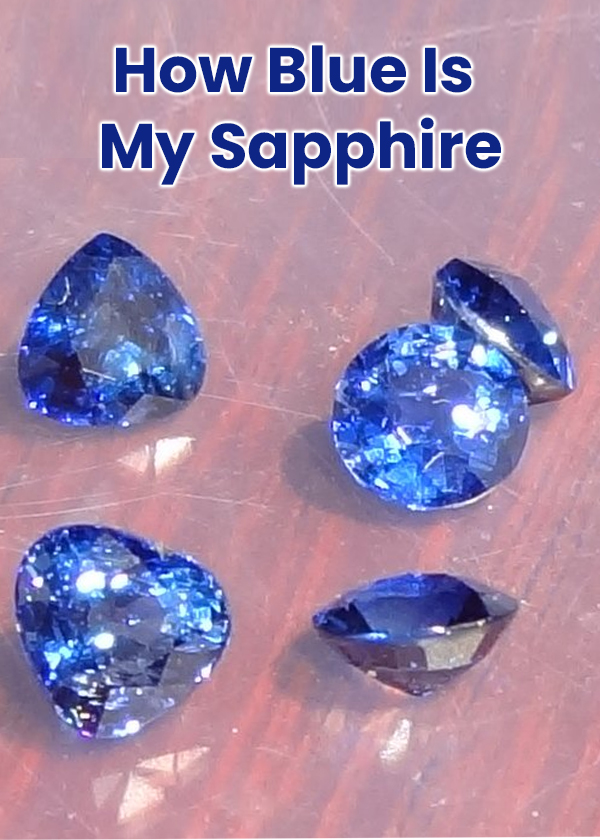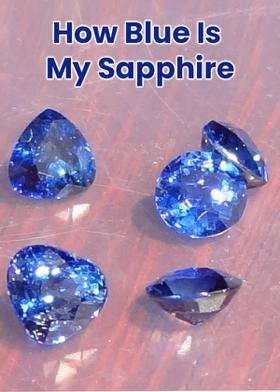How Blue Is My Sapphire
How Blue Is My Sapphire


All of us live with our past. All of us allow it to shape our future. But some of us know how to shrug the past. I think that is who I am…
“There’s good news; we are pleased to sponsor your visit to Hamburg so that you can go there and make your presentation at the Eyecare and Optics Congress. Please tell us as to what you wish us to do: book your air tickets, pay your delegation fee, or book your hotel”, read the e-mail message from the executive director of The Eyewear and Contact Lens Company based in Germany.
The day was May 5, 2016, and the time 10.30 P.M. I was on my computer for the usual after-dinner 15-minute ritual of checking my e-mails. I’m a 76-years-old healthy self-employed eye-care professional, having earlier served at a prestigious medical institution in New Delhi for a long time. I’m the maker of Ptosis spectacles (to lift the drooping upper lid in cases where the oculo-plastic surgeon says `no’ to surgery), Fabric Occluder (to cover the better eye while exercising the amblyopic eye), and Ear Plugs (to muffle sound in noisy surroundings).
I consume healthy vegetarian food that includes fruits and vegetables, dry fruit, and curd. I eat in moderation, eat slowly following the adage `roti pio paani khao’, go for morning walk, indulge in simple exercises, drink adequate water, and take sufficient sleep of around seven hours.
I’m the son of a hard-working father, who believed in the dictum `simple living and high thinking’. My father only studied for two or three classes in school. He was the son of a mother, made poor by her cash- and property-loving relatives. My father worked initially as a helper with a `munshi’, who having recognized his wish to do something better, helped my father learn to read and write Urdu, then to sit for an examination, and ultimately to become a Petition Writer to settle down in a small town in Haryana, where he gradually becomes a very respectable person.
I passed the Matriculation examination in the first division. My father wanted me to become a doctor. But I had not opted science; I had studied drawing instead and wanted to be an artist, but above all, I loved my father. For studying Biology, that was not a subject to be taught at either of the two colleges in the town, I went to a Government college in a nearby town, and on the recommendation of a known lecturer, coupled with my resolve to work hard, got admission in Inter Science (Medical Group) course.
However, although I was the only student out of a batch of six to have cleared the FSc (Medical) examination (I did so in third division), and could not secure admission in a medical college. The next best thing appeared to be in doing the two-year Diploma in Optometry course from Gandhi Eye Hospital School of Optometry at Aligarh, securing the first position in U.P. State Medical Faculty Lucknow examination.
I served as Refractionist at a Sir Ganga Ram Hospital in New Delhi for thirty long years, and side-by-side earned the five-year Degree in Ayurvedic Medicine and four-week Certificate in Rehabilitation qualifications.
I have been serving as editor of Optometry Today quarterly journal ever since its inception in the year 1970, and have authored `Ophthalmic Dispensing Optics’ book for eye care professionals and `Babloo goes for an eye test’ book for students, parents and teachers. I have always believed in the age-old saying ` God helps those who help themselves’, and have done vision screening of thousands of school children in their respective institutions.
My abstract of a scientific paper, detailing the accessory to lift the drooping upper lid, had already been accepted by the organizers of the Congress, and I had applied for sponsorship to cover the delegation fee, air-travel and accommodation. Not only I but also other members of the family were extremely happy at this unexpected but greatly needed outcome.
My family consists of my 80-years-old uncle, Ram Avtar, a successful businessman; my 69-years-old sister, Rama, a religious lady; and my 67-years-old wife, Sheela, a beautiful younger-looking smart lady ever busy on Whats-App on her cell-phone.
Early morning that day, my sister, Rama had started a debate on the necessity of adopting cautionary approach to the wearing of a sapphire stone, saying that it could either make or mar the life of an individual, and citing the example of her late husband having worn a sapphire without testing about its suitability, and having suffered various types of losses and ultimately having passed away due to a seemingly small ailment at the prime age of 59 years.
According to Vedic astrology, the blue sapphire represents the planet Saturn (`Shani’), and is an effective, as well as destructive, gemstone. It is said that if blue sapphire gives good effect, the wearer can achieve huge success in life and that too within no time. A good quality sapphire is expensive. It can be worn in a gold or silver ring in the middle finger, after its purification by dipping it in milk, honey and `ganga jal’ for thirty minutes, burning incense sticks in the name of `Shani Dev’ and offering prayer.
Gemstones are classified into different varieties. For example, ruby is the red variety of the species corundum, while any other colour of corundum is considered sapphire. Other examples are the emerald (green), acquamarine (blue), red beryl (red), goshenite (colourless), heliodor (yellow), and morganite (pink), which are all varieties of the mineral species beryl. Gems are characterized in terms of refractive index, dispersion, specific gravity, hardness, cleavage, fracture, and luster.
Synthetic gems are physically, optically and chemically similar to the natural stone, but these are created in controlled conditions in a laboratory. Imitation stones can be glass, plastic, resins or other compounds. Examples of imitation stones include cubic zirconia, compound of zirconium oxide and simulated moissanite. The imitations copy the look and colour of the real stone but possess neither their chemical nor physical characteristics. Moissanite actually has a higher refractive index than diamond and will have more `fire’ than an equivalently sized and cut diamond.
Synthetic, cultured or lab-created gemstones are not imitations. For example, diamonds, rubies, sapphires and emeralds have been manufactured in labs to possess identical chemical and physical characteristics to the naturally occurring variety. Synthetic corundum, including rubies and sapphire, is very common and costs much less than the natural stones. Smaller synthetic diamonds have been manufactured in large quantities as industrial abrasives, although large or gem-quality synthetic diamonds are becoming available in multiple carats.
Whether a gemstone is a natural stone or lab-created, the physical properties are the same. Lab-created stones tend to have a more vivid colour to them, as impurities are not present in a lab and do not modify the clarity or colour of the stone, unless added intentionally for a specific purpose.
Many people are confused or even afraid of wearing a blue sapphire. It is generally believed that this stone makes one’s mind calmer, sharper, and therefore helps one to do things in a proper manner. If it doesn’t suit you, then it creates a lot of pain in your arms and legs, makes you take wrong decisions, and, hence, you start fighting all kinds of people and you start misusing your money – that can cause you to become poor ultimately due to the bad effect of your decision-making abilities.
Not believing in this hypothesis, and taking up the challenge, I had bought a sapphire ring as the first thing as the market opened, and put it on my finger. My sister was naturally furious, and to make matter worse, our uncle had soon slipped while descending from stairs and sprained his leg. My sister took no time to attribute our uncle’s fall to the `ashubh’ sapphire.
The news of my sponsorship had added to my sister’s dilemma, as, although she was very happy, she could not now openly attribute the development to the `chamatkari’ sapphire. While everybody, including our uncle, was jubilant, my sister was in a fix. Likewise, I, too, even if it was only for a fleeting moment, dwelt on the thought as to `how blue is my sapphire!’






















































